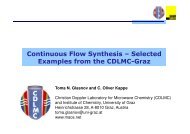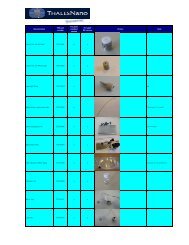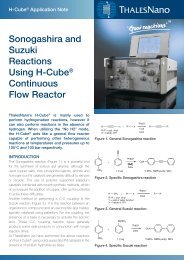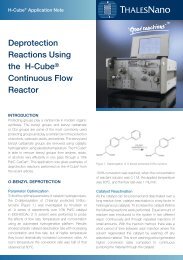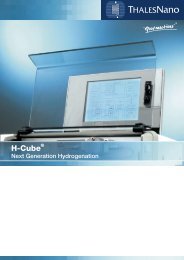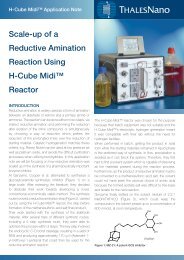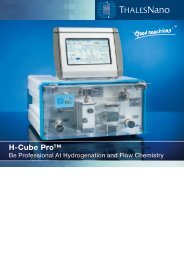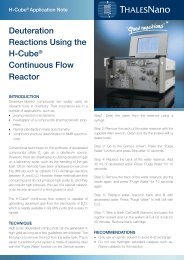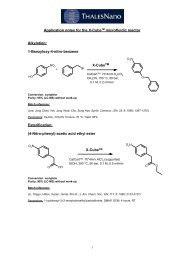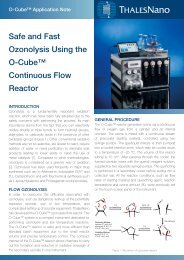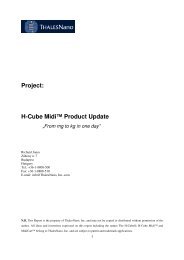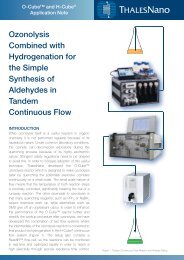nation Reaction Examples Using the H-Cube® flow ... - ThalesNano
nation Reaction Examples Using the H-Cube® flow ... - ThalesNano
nation Reaction Examples Using the H-Cube® flow ... - ThalesNano
You also want an ePaper? Increase the reach of your titles
YUMPU automatically turns print PDFs into web optimized ePapers that Google loves.
H-Cube ® Application Note<br />
Fast Hydroge<strong>nation</strong><br />
<strong>Reaction</strong><br />
<strong>Examples</strong> <strong>Using</strong><br />
<strong>the</strong> H-Cube ® <strong>flow</strong><br />
reactor<br />
The hydroge<strong>nation</strong> of a series of functional groups<br />
has been performed using H-Cube ® , a novel continuous-<strong>flow</strong><br />
microfluidic hydroge<strong>nation</strong> reactor.<br />
These experiments demonstrate that <strong>the</strong> H-Cube ®<br />
can perform a diverse range of heterogeneous<br />
hydroge<strong>nation</strong> reactions with high yields and conversion<br />
rates, and with reaction times of minutes. For<br />
example, 162 mg of 5-nitroindole was reduced in less<br />
than 10 minutes in quantitative yield.<br />
INTRODUCTION<br />
Heterogeneous catalytic hydroge<strong>nation</strong> is one of <strong>the</strong> most<br />
important techniques for <strong>the</strong> reduction of functional groups,<br />
but is severely limited by harsh experimental conditions and<br />
<strong>the</strong> potential hazard of handling pyrophoric catalysts (1), (2).<br />
Hydroge<strong>nation</strong> at elevated temperatures and pressures is<br />
accomplished in autoclave reactors, normally requiring specially<br />
trained staff and dedicated laboratory facilities. The use of<br />
<strong>the</strong> batch process means <strong>the</strong> size of <strong>the</strong> reaction<br />
is dependent upon <strong>the</strong> capacity of <strong>the</strong> device, which<br />
cannot be decreased or increased past certain limits, without<br />
changing <strong>the</strong> reactor. To address <strong>the</strong>se limitations,<br />
<strong>ThalesNano</strong> has developed <strong>the</strong> H-Cube ® , which generates<br />
hydrogen internally through <strong>the</strong> electrolysis of water, and<br />
through a novel CarCart ® system, negates pyrophoric<br />
catalyst filtration. To demonstrate <strong>the</strong> capabilities of H-Cube ®<br />
at reducing a wide range of functional groups, <strong>the</strong> six<br />
specific groups shown above, were reduced and <strong>the</strong><br />
conversion and yield summarised. The efficiency of <strong>the</strong> mixing<br />
between <strong>the</strong> catalyst, substrate, and hydrogen in <strong>the</strong><br />
H-Cube ® is also highlighted and compared with that of<br />
a conventional batch reactor.<br />
STANDARD EXPERIMENTAL PROTOCOL<br />
The reaction solvent was initially allowed to <strong>flow</strong> through<br />
<strong>the</strong> CatCart ® for 1 minute. Hydrogen production was <strong>the</strong>n<br />
activated, and <strong>the</strong> mixture of solvent and hydrogen was<br />
allowed to <strong>flow</strong> through <strong>the</strong> solvent for 10 minutes to prepare<br />
<strong>the</strong> catalyst. The catalysts used were 10% Pd/C, 10% Pt/C<br />
or Raney/Nickel. The <strong>flow</strong> rate of <strong>the</strong> system was initially set to<br />
1 mL/min, <strong>the</strong> hydrogen pressure to 1 bar, and <strong>the</strong> reaction<br />
allowed to commence.<br />
When higher conversion rates were required, <strong>the</strong> temperature<br />
parameter was increased while <strong>the</strong> reaction was in progress.<br />
After passing through <strong>the</strong> instrument, <strong>the</strong> total<br />
amount of reaction mixture was collected, and <strong>the</strong> column<br />
was washed through with <strong>the</strong> solvent mixture to<br />
remove any substrate still adsorbed to <strong>the</strong> catalyst. The two<br />
solutions were combined and analyzed by thin layer chromatography<br />
to assess purity. The used CatCart ® was removed<br />
and placed in a deactivating solution of sodium hydrogen<br />
sulfite (1 M).<br />
NITRO REDUCTION<br />
Reduction of nitro compounds is an important route to <strong>the</strong><br />
formation of amines, which are often used as a drug building<br />
block. The formation of amines usually take place under mild<br />
conditions, for example, room temperature and low pressure (3).
H-Cube ® Application Note H-Cube ® Application Note<br />
Experimental procedure<br />
<strong>Using</strong> 10% Pd/C as catalyst, 20 mL of 5-nitroindole (1 mmol;<br />
162 mg) in a 1:1 mixture of ethyl acetate was pumped<br />
through <strong>the</strong> H-Cube ® . The pressure of <strong>the</strong> system was set<br />
to 1 bar, and <strong>the</strong> temperature to room temperature. After<br />
20 minutes, all <strong>the</strong> reaction mixture had passed through <strong>the</strong><br />
H-Cube ® . The CatCart ® was <strong>the</strong>n washed with ethanol for<br />
approximately 10 minutes. The fraction was analyzed using<br />
TLC, which showed complete conversion to <strong>the</strong> product,<br />
and <strong>the</strong> solvent was reduced to dryness, affording <strong>the</strong><br />
product in 98% yield. The reaction was repeated at 2 mL/min<br />
producing <strong>the</strong> same conversion and yield within 10 minutes.<br />
HETEROCYCLE SATURATION<br />
Nicotinic acid esters are important intermediates for <strong>the</strong><br />
preparation of commercial herbicides, anti-allergy agents, and<br />
for <strong>the</strong> treatment of gastric and duodenal ulcer diseases (4).<br />
Experimental procedure<br />
<strong>Using</strong> 10% Pd/C, 40% EtOH in water as solvent, 90˚C and a<br />
pressure of 80 bars, a number of nicotinic acid ester analogs<br />
were reduced at a <strong>flow</strong> rate of 1 mL/min and a concentration of<br />
0,05 M. 1 H-NMR analysis showed average product purity of >95%.<br />
DOUBLE-BOND SATURATION<br />
Carbon-carbon double bonds are readily hydrogenated<br />
unless highly-substituted and sterically hindered. Most easily<br />
hydrogenated alkenes can be reduced at atmospheric<br />
pressure and temperature, although use of elevated temperatures<br />
and/or pressures can increase reactivity substantially (5).<br />
Experimental procedure<br />
The reduction of 1 mmol (103 mg) of trans, trans-1,4-diphenyl-<br />
1,3-butadiene on <strong>the</strong> H-Cube ® took only 10 minutes using<br />
10% Pd/C at room temperature and 1 bar affording a 96%<br />
yield.<br />
NITRILE REDUCTION<br />
The reduction of nitriles is of industrial importance, and has<br />
been applied to <strong>the</strong> commerical production of various amines,<br />
for example, various aliphatic amines from fatty acid nitriles (6).<br />
Experimental procedure<br />
The reaction was carried out using dry solvents and flamedried<br />
glassware. All starting materials, solvents and products<br />
were kept under an argon atmosphere. <strong>Using</strong> Raney Nickel<br />
as catalyst, a dry solution of 2.0 M of ammonia in methanol<br />
under argon was flushed through <strong>the</strong> system at 1 mL/min for<br />
5 minutes at 80˚C and 50 bars, with a constant <strong>flow</strong> of hydrogen.<br />
The <strong>flow</strong> was stopped, and a solution of 2-methoxy-1-<br />
naphthonitrile (92 mg, 1 mmole) in 10 mL of 2.0 M of ammonia<br />
in methanol under argon was <strong>the</strong>n pumped through <strong>the</strong><br />
system at a <strong>flow</strong> rate of 1 mL/min.<br />
PROTECTING-GROUP HYDROGENOLYSIS<br />
The use of benzyl and carbobenzyloxy functionalities as<br />
protecting groups is an important facet of chemoselectivity.<br />
The C-N, or C-O bonds can undergo facile cleavage in <strong>the</strong><br />
presence of a metal catalyst and hydrogen (7).<br />
Experimental procedure<br />
Carbobenzyloxy-protected tryptamine was subjected to<br />
hydrogenolysis using H-Cube ® . The hydrogenolysis of <strong>the</strong><br />
N-carbobenzyloxy-tryptamine proceeded smoothly at 60˚C<br />
and 1 bar affording a quantitative yield.<br />
REDUCTIVE ALKYLATION<br />
The direct reductive ami<strong>nation</strong> (DRA) of aldehyde and ketones<br />
is an important reaction in organic chemistry with a great<br />
potential for application in industry.<br />
Reductive ami<strong>nation</strong> carried out using heterogeneous catalysts<br />
has one main advantage over <strong>the</strong> use of o<strong>the</strong>r reducing<br />
agents, for example, boranes, which is <strong>the</strong> avoidance of any<br />
waste production (8).<br />
Experimental procedure<br />
The imine was formed in situ by mixing <strong>the</strong> aldehyde and<br />
amine in dry methanol (10 mL) using 4Å molecular sieves<br />
under argon. The imine was <strong>the</strong>n passed through <strong>the</strong> system<br />
at room temperature and 1 bar pressure, a <strong>flow</strong> rate of 1 mL/<br />
min, and Raney Ni as catalyst, for 10 minutes. NMR analysis<br />
at <strong>the</strong> end of <strong>the</strong> experiment showed 97% product conversion.<br />
H-CUBE ® AND BATCH REACTORS:<br />
A COMPARISON<br />
The residence time of <strong>the</strong> substrate in a 30x4 mm CatCart ®<br />
is 30 seconds. A 2 mL sample of dissolved substrate will<br />
<strong>the</strong>refore take 2 minutes and 30 seconds to pass through <strong>the</strong><br />
catalyst at a <strong>flow</strong>-rate of 1 mL/min.<br />
To show a comparison in <strong>the</strong> efficiency of a reaction performed<br />
in <strong>the</strong> H-Cube ® with that of one performed in a conventional<br />
batch reactor, <strong>the</strong> following experiment was performed.<br />
BATCH REACTOR TEST<br />
135 mg of 10% Pd/C (<strong>the</strong> amount of catalyst present in<br />
a 30x4 mm CatCart ® ) was added to a 2 mL solution of 5-nitroindole<br />
(0.05 M) and placed in a reaction bomb. The reaction<br />
mixture was flushed with nitrogen 3 times, and <strong>the</strong>n flushed with<br />
hydrogen at a pressure of 1 bar and at room temperature.<br />
The reaction was stirred vigorously for 2 minutes and 30<br />
seconds, and <strong>the</strong> hydrogen was <strong>the</strong>n evacuated from <strong>the</strong><br />
reactor. The reaction mixture was filtered, reduced to dryness,<br />
and an 1 H-NMR taken to obtain a % conversion.<br />
H-CUBE ® TEST<br />
A CatCart ® was washed with only ethanol, and a 2 mL<br />
solution of 5-nitroindol was <strong>flow</strong>ed through <strong>the</strong> catalyst at<br />
1 mL/min at room temperature and 1 bar. The total reaction<br />
time was 2 minutes and 30 seconds. The resulting solution<br />
was reduced to dryness, and an NMR sample taken.<br />
Both reactions were performed twice.<br />
www.thalesnano.com<br />
RESULTS AND DISCUSSION<br />
The results of <strong>the</strong> batch reactor and H-Cube ® experiments<br />
are as follows:<br />
From <strong>the</strong> results we can see that <strong>the</strong> efficiency of <strong>the</strong><br />
H-Cube ® is substantially greater than that of <strong>the</strong> batch<br />
reactor. In a typical batch reactor, a stirred suspension of<br />
substrate and catalyst is reacted under an atmosphere of<br />
hydrogen. The mass-transfer between <strong>the</strong> gas-liquid and<br />
liquid-solid phases in a batch reactor is <strong>the</strong>refore, very low<br />
since <strong>the</strong>re is a low interfacial area between <strong>the</strong> three phases.<br />
In <strong>the</strong> H-Cube ® , <strong>the</strong> dissolved substrate and hydrogen<br />
<strong>flow</strong> through <strong>the</strong> microchannels formed by <strong>the</strong> compressed<br />
catalyst. The interfacial area between <strong>the</strong> three phases is<br />
higher, resulting in a more efficient gas-liquid-solid reaction as<br />
demonstrated by <strong>the</strong> better product conversion.<br />
The efficiency of <strong>the</strong> H-Cube ® is fur<strong>the</strong>r demonstrated from<br />
<strong>the</strong> results of <strong>the</strong> 6 reductions, as summarised in Table 2,<br />
overleaf.
CONCLUSION<br />
These experiments demonstrate that <strong>the</strong> H-Cube ® can<br />
perform heterogeneous hydroge<strong>nation</strong> reactions with high<br />
yields and conversion rates.<br />
The H-Cube ® was capable of reducing quantities of up to<br />
2 mmols within minutes, and all reactions were consistently<br />
reproduced. The reactions can be easily monitored,<br />
allowing a rapid optimization of <strong>the</strong> reaction conditions. No<br />
filtration was required with just <strong>the</strong> solvent reduced to dryness<br />
to yield <strong>the</strong> product in a pure form.<br />
Current investigations centre around <strong>the</strong> use of novel immobilised<br />
palladium catalysts for <strong>the</strong> asymmetric reductions of<br />
ketones.<br />
Work is also underway towards <strong>the</strong> integration of <strong>the</strong><br />
H-Cube ® with an automated liquid handler for <strong>the</strong> multiple<br />
reductions of small scale compounds as part of a final step<br />
library syn<strong>the</strong>sis.<br />
REFERENCES<br />
(1) Adkins, H.; Cramer, H.I. J. Am. Chem. Soc. 1930, 52, 4359.<br />
(2) Reynolds, M.P.; Greenfield, H. Chem. Ind. 1996, 68, 371.<br />
(3) Baumeister, P.; Blaser, H.U.; Studer, M. Catal. Lett. 1997,<br />
49, 219.<br />
(4) Moon, M. S. et al, Bull. Korean Chem. Soc. 2001, Vol. 22, 1167.<br />
(5) (a) Lebedev, S.V.; Platonov, M. J. Chem. Soc. 1930, 321.<br />
(b) Peters, J. A.; van Bekkum, H. Rec. Trav. Chim. Pays.-Bas,<br />
1971, 90, 1323.<br />
(6) (a) Schwoegler, E. J.; Adkins, H. J. Am. Chem. Soc. 1939, 69,<br />
3499.<br />
(b) Freifelder, M. Am. Soc. 1960, 82, 2386.<br />
(7) Clayden, J.; Warren, S.; Greeves, N.; Wo<strong>the</strong>rs, P. Organic<br />
Chemistry, Oxford University Press, 2001, 653.<br />
(8) Vitali, I. T.; Börner, A. Adv. Synth. Catal. 2004, 346, pp 561-565.<br />
If you require fur<strong>the</strong>r information on <strong>the</strong> instrument, or would like to<br />
have a Demonstration scheduled, please contact:<br />
<strong>ThalesNano</strong> Inc.<br />
Záhony u. 7.<br />
H-1031 Budapest, Hungary<br />
Tel: (36 1) 880 8500<br />
Fax: (36 1) 880 8501<br />
Thales LLC,<br />
Princeton, NJ, USA<br />
Tel: (1) 732 274 3388<br />
E-mail: info@thalesnano.com<br />
www.thalesnano.com<br />
Thales Nanotechnology is a specialized developer<br />
and provider of microfluidic <strong>flow</strong> instruments for<br />
chemistry laboratories. Our development philosophy<br />
is based on exploiting <strong>the</strong> benefits available through<br />
combining micro- and nano-scale technologies with<br />
<strong>flow</strong> chemistry.



